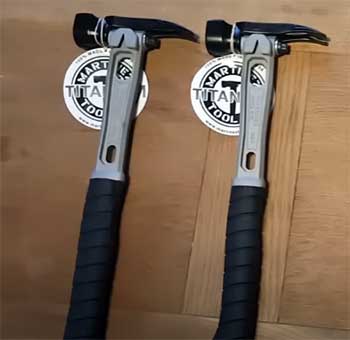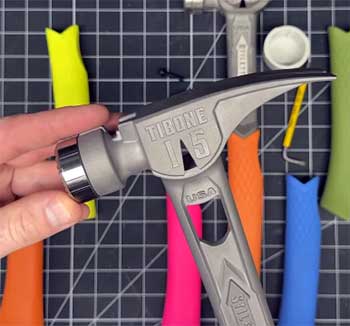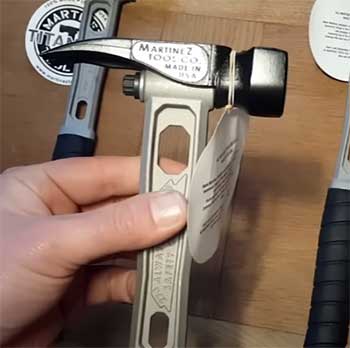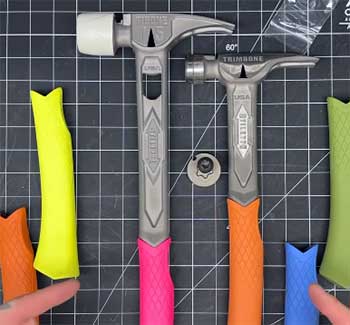I’ve swung hammers for years, from framing houses to tackling light demo work, and I’ve learned one thing: the right tool can make or break your day. Martinez and Stiletto hammers are the talk of the trade, both boasting titanium builds and premium price tags.
In this article, I’m breaking down their pros and cons, sharing my hands-on experience, and helping you decide which hammer deserves your tool belt.
Whether you’re a pro or a weekend warrior, let’s figure out which one’s worth your hard-earned cash.
A Brief Comparison Table
| Feature | Martinez M1/M4 | Stiletto TiBone/Trimbone |
| Head Material | Steel (replaceable) | Titanium with steel face (replaceable) |
| Handle Material | Titanium or wood | Titanium or wood |
| Weight (oz) | 12-15 (M4), 15 (M1) | 10-15 (Trimbone), 15 (TiBone) |
| Handle Length | 16-18 inches (varies by model) | 16-18 inches (varies by model) |
| Grip | Replaceable, tacky tape | Replaceable, rubberized |
| Customization | Modular heads, handles, grips | Modular faces, grips, some models |
| Nail Puller | Side puller, flat claws | Side puller, curved claws |
| Best For | Framing, concrete forms, remodeling | Framing, finish work, general carpentry |
| Price Range | $200-$350 | $200-$300 |
| Made In | USA | USA (TiBone), China (some wood-handled) |
Why I’m Comparing These Hammers?
As a carpenter, I’ve felt the sting of elbow pain after a long day of swinging a heavy steel hammer. That’s why titanium hammers like Martinez and Stiletto caught my eye—they promise less weight, less recoil, and more durability.
Both brands come from the mind of Mark Martinez, who revolutionized hammers with titanium at Stiletto before starting his own company. I’ve used both extensively, and I’m here to share what makes each shine (or falter) in real-world scenarios.
Let’s break down the key features, my experiences, and where each hammer fits best.
Martinez Hammers: My Experience

When I first picked up a Martinez M1, it felt like an extension of my arm.
The balance was unreal—head-heavy in a good way, delivering serious driving power with minimal effort.
The M1 and M4 models, both with steel heads and titanium or wood handles, are built for pros who swing all day.
The M1 is a 15-ounce framing beast, while the M4, at 12-15 ounces, leans toward remodeling or lighter tasks.
Their modular design lets me swap heads, handles, and grips in minutes, which is a game-changer for customizing on the fly.
Pros of Martinez Hammers
The weight distribution is what hooked me. The steel head, paired with a titanium handle, channels nearly all my swing energy into the nail—97% efficiency, compared to 70% for steel hammers.
This means fewer swings to sink a 16d nail, which saves my arm from fatigue. The titanium handle absorbs shock like a sponge, making my days framing or setting concrete forms far less punishing. I’ve used the M1 for heavy framing and the M4 for plaster and lath demo, and both feel like they’ll outlast me.
Customization is another win. I can switch between milled and smooth faces depending on the job—milled for framing, smooth for finish work. The dovetail head attachment is rock-solid, secured with a bolt, and I’ve never had it loosen, even after months of hard use.
The tacky grip tape is a nice touch, keeping my hand locked in even when it’s sweaty. Plus, Martinez hammers are 100% made in the USA, which matters to me as a craftsman who values quality and local production.
Cons of Martinez Hammers
But it’s not all perfect. The M1’s head-heavy design, while great for power, can strain my wrist on the backswing, especially after hours of framing. I’ve heard similar complaints from others with tendonitis.
The M4, being lighter, avoids this but lacks the raw power for heavy-duty tasks like driving nails into dense hardwood. The flat claws are fantastic for prying beams but less effective for pulling nails compared to curved designs.
And let’s talk price—$200 to $350 is steep. I justify it because I’m a pro, but for hobbyists, it’s a tough sell.
Another gripe is availability. Martinez is a small, family-run company, and their stock can be spotty. I’ve waited weeks for a custom order, and their customer service, while knowledgeable, sometimes feels dismissive if you’re not a “tool nerd” like them.
The grip tape, while grippy, wears out faster than I’d like—about three years for me, though it’s easy to replace. Lastly, the M4’s dimple face, designed for precision, doesn’t always grip nails as well as a milled face, which can lead to glancing blows if I’m not careful.
Stiletto Hammers: My Take

Stiletto’s TiBone and Trimbone are the OGs of titanium hammers, and I’ve swung both for years.
The TiBone, at 15 ounces, is a framing powerhouse, while the 10-ounce Trimbone is a finish carpenter’s dream.
Their titanium heads with replaceable steel faces strike a balance between durability and weight savings.
I love the TiBone’s oversized strike face—it’s forgiving if my aim’s off after a long day.
The side nail puller is a standout, especially on the Trimbone, with its curved design that minimizes wood damage.
Pros of Stiletto Hammers
The TiBone hits like a freight train but feels like a feather. Its titanium chassis reduces recoil to almost nothing—my elbow thanks me every time I use it. The magnetic nail starter is a godsend for one-handed starts, especially when I’m balancing on a ladder.
The Trimbone, being lighter, is perfect for tapping in electrical staples or finish nails without overdriving. Both have replaceable rubberized grips that feel great, though they’re a bit spongier than Martinez’s tape. Stiletto’s balance is spot-on, with a slightly longer arc that suits my swing style.
Stiletto’s modularity is solid, though not as extensive as Martinez. I can swap steel faces or add a mallet cap for versatility. The TiBone’s side nail puller is a beast, offering massive leverage for yanking out 16d nails.
I’ve used it for light demo, like ripping out old studs, and it holds up. The Trimbone’s curved side puller is a game-changer for finish work, letting me pull nails without leaving a crater. Stiletto’s also more accessible than Martinez, with better distribution at hardware stores.
Cons of Stiletto Hammers
Stiletto’s not flawless. The TiBone’s titanium head, while durable, can shear bolts or misalign over time, reducing the nail starter’s effectiveness. I’ve had to send mine in for repairs, which is a hassle, though their warranty is decent.
The Trimbone, at 10 ounces, feels underpowered for framing—fine for finish work, but I wouldn’t use it for concrete forms. The grips, while comfy, start to tear after heavy use (about two years for me), and replacements aren’t cheap. Also, some Stiletto models, like their wood-handled ones, are made in China, which bugs me given the price.
The biggest drawback is cost. At $200-$300, Stiletto’s in the same league as Martinez, but I’ve noticed the TiBone’s steel face wears faster than Martinez’s full steel head. For pros, it’s worth it, but if you’re not swinging daily, a $30 Estwing might do.
I’ve also found the TiBone’s curved claws less versatile for prying beams compared to Martinez’s flat claws. Lastly, Stiletto’s owned by Milwaukee, which means some models might not have the same “soul” as Martinez’s small-batch craftsmanship.
Head-to-Head Comparison of Martinez And Stiletto Hammers
Let’s get into the meat of it—how do these hammers stack up in real-world use?
- Weight and Balance

Martinez’s M1 feels heavier up front, which I love for framing.
It drives nails with less effort, but the head-heavy design takes getting used to.
The M4 is lighter, better for remodeling or finish work, but it lacks the M1’s punch.
Stiletto’s TiBone has a more even balance, making it easier to swing all day without wrist strain.
The Trimbone’s featherweight 10 ounces is perfect for precision but feels flimsy for heavy tasks. If you’re framing, I’d lean toward the M1 or TiBone; for finish work, the Trimbone or M4.
- Durability
Both brands are built to last, but Martinez edges out slightly. The M1’s steel head and titanium handle have taken a beating—concrete forms, plaster demo, you name it—and it’s still pristine. The dovetail attachment is bombproof.
Stiletto’s TiBone is tough, but I’ve had issues with the steel face loosening after years of hard use. The Trimbone holds up well for lighter tasks, but I wouldn’t trust it for demo. Martinez’s full steel head feels like it’ll outlive Stiletto’s replaceable face, especially for heavy-duty work.
- Ergonomics
Ergonomics is where personal preference kicks in. Martinez’s tacky grip tape is grippier than Stiletto’s rubberized handle, especially when my hands are sweaty. But Stiletto’s grips feel softer, which some might prefer for long sessions.
The M1’s straight handle suits my swing, but I know framers who love the TiBone’s slight curve for extra leverage. The M4’s shorter handle is great for tight spaces, while the Trimbone’s length gives it finesse. If you’ve got elbow issues, both brands’ titanium handles reduce shock, but Martinez feels a touch smoother.
- Versatility
Martinez wins on versatility. The modular system lets me mix and match heads, handles, and grips for any job—framing, remodeling, even light metalwork. I’ve used the M1 for concrete forms and the M4 for siding, and both excel.
Stiletto’s modularity is good but limited—face swaps and mallet caps are handy, but you can’t change the handle material on most models. The TiBone is a framing specialist, while the Trimbone shines for finish work. If you need one hammer for everything, Martinez’s system is hard to beat.
- Price and Value
Both brands are pricey—$200-$350 for Martinez, $200-$300 for Stiletto. As a pro, I see them as investments. Martinez’s customization and USA-made quality justify the cost if you’re swinging daily. Stiletto’s slightly lower price and wider availability make it more accessible, but the Chinese-made wood-handled models feel like a compromise.
For hobbyists, both might be overkill compared to a $25 Estwing. If you’re battling elbow pain or need a hammer to last decades, the value’s there for either.
My Real-World Testing
I’ve put these hammers through their paces on various jobs. On a recent framing project, the Martinez M1 sank 16d nails into Douglas fir like butter, needing only one or two swings. The TiBone matched it but felt smoother on the wrist due to its balance.
For demo, I used the M1 to pry apart old studs—its flat claws dug in without slipping. The TiBone’s curved claws struggled a bit here but excelled at pulling nails. On a finish job, the Trimbone’s light weight and curved side puller were perfect for delicate work, while the M4’s dimple face left minimal marks.
For concrete forms, the M1’s weight and shock absorption made it my go-to. The TiBone held up but felt less robust when striking form stakes. The M4 was underpowered here, and the Trimbone wasn’t even in the conversation.
Both brands’ titanium handles saved my arm from the jarring vibrations I’d get with a steel hammer, but Martinez’s steel head gave me more confidence for heavy hits.
Who Are These Hammers For?

Martinez hammers are for pros who need versatility and durability.
If you’re framing, doing concrete work, or switching between tasks, the M1 and M4’s modular system is a dream.
They’re ideal for carpenters who value customization and don’t mind paying for USA-made quality.
Stiletto’s TiBone is for framers who want a reliable, balanced hammer with less wrist strain.
The Trimbone suits finish carpenters or remodelers who prioritize precision and light weight. If you’re a DIYer or only use a hammer occasionally, stick with a cheaper steel option.
My Personal Pick
After years of swinging both, I lean toward Martinez. The M1’s power and modularity fit my framing-heavy workload, and the USA-made craftsmanship feels worth the extra bucks. That said, the TiBone’s balance and nail starter make it a close second, especially for long framing sessions.
The Trimbone’s a gem for finish work, but I rarely need such a light hammer. Your choice depends on your needs—framing or finish, heavy or light, custom or stock. Try swinging both if you can; your arm will tell you what’s right.
Frequently Asked Questions (FAQ)
Martinez hammers stand out for their modular design, allowing you to swap heads, handles, and grips. Their steel heads and titanium handles deliver power with minimal recoil, perfect for pros who need durability and versatility.
A Martinez hammer is most comparable to a Stiletto hammer, particularly the TiBone or Trimbone, due to their shared titanium construction and focus on reducing arm strain for professional carpenters.
Yes, Stiletto is owned by Milwaukee Tool, which acquired the brand in 2007. They continue to produce high-end titanium hammers under the Stiletto name.
Yes, Milwaukee Tool owns Stiletto, having purchased it from Mark Martinez. Some models are made in the USA, while others, like wood-handled versions, are produced in China.
Wrapping It Up
You’ve got two heavyweights here—Martinez and Stiletto, both built to make your workday easier and your joints happier. I’ve shared my swings, my gripes, and my wins with both, and I hope you’ve got a clearer picture of which hammer fits your needs.
Whether you’re framing a house or finesse-finishing a cabinet, pick the one that feels right in your hand and suits your budget. You can’t go wrong with either, but your choice might just change how you swing for years to come.
